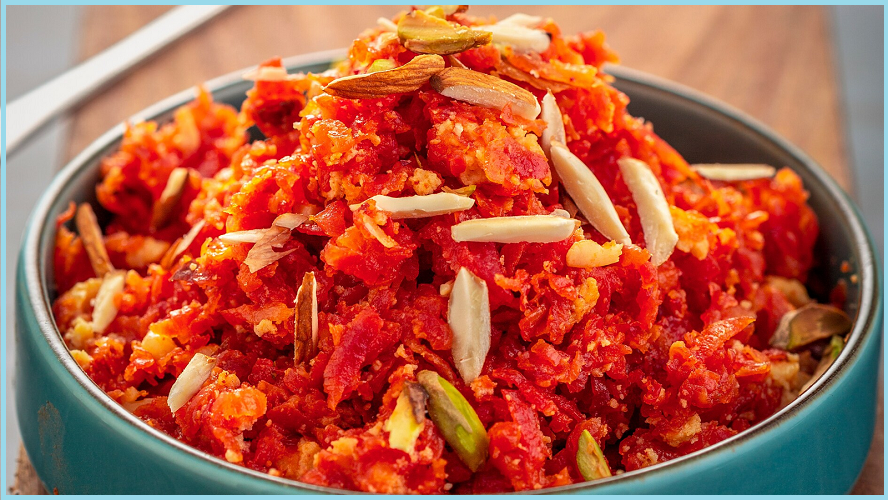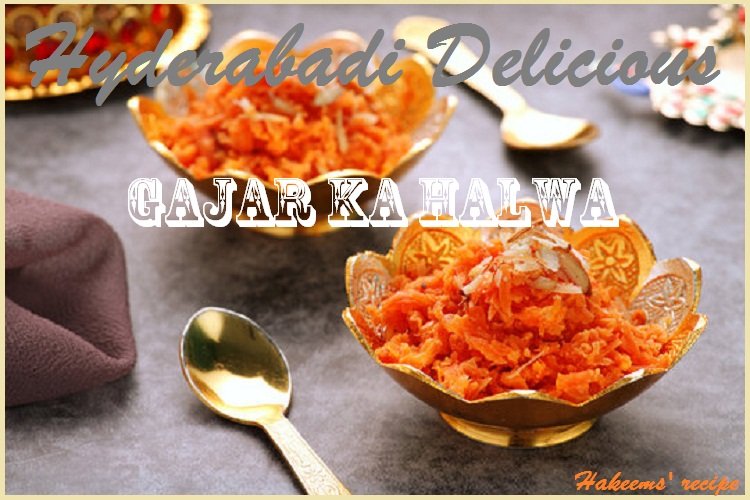
Irresistible Hyderabadi Gajar Ka Halwa: Introduction
Hyderabadi Gajar Ka Halwa, also known as Carrot Halwa, is a popular Indian dessert made from grated carrots, milk, sugar, and ghee. It’s a rich, sweet, and aromatic dish that’s often prepared during festivals and special occasions. This guide will take you through each step of the process, ensuring you can make this traditional dessert with ease and perfection.
Chapter 1: Gathering Your Ingredients
Before you start, make sure you have all the necessary ingredients ready.Here’s what you’ll need:
Carrots: 1 kg, grated
Milk: 1 liter, full cream
Sugar: 250 grams (adjust to taste)
Ghee: 4 tablespoons
Cardamom Powder: 1 teaspoon
Cashews: 10-15, chopped
Almonds: 10-15, chopped
Raisins: 20-25
Khoya (Mawa): 200 grams (optional for extra richness)
Ensuring everything is prepared in advance will make the cooking process smooth and efficient.
Chapter 2: Preparing the Carrots
The first step in making Hyderabadi Gajar Ka Halwa is to prepare the carrots.
Washing and Peeling: Thoroughly wash the carrots to remove any dirt. Use a vegetable peeler to remove the outer skin.
Grating: Grate the carrots using a medium-sized grater. The grated carrots should be fine but not too mushy.
This step is crucial as it determines the texture of the final dish.
Chapter 3: Cooking the Carrots in Milk
Once your carrots are prepared, it’s time to cook them in milk. This step imparts a rich, creamy texture to the halwa.
Heating the Milk: In a large heavy-bottomed pan or kadhai, pour the milk and bring it to a boil over medium heat.
Adding the Carrots: Once the milk starts boiling, add the grated carrots to the pan. Stir well to combine.
Cooking: Cook the mixture on medium heat, stirring occasionally. This process will take around 30-40 minutes. The milk will gradually reduce, and the carrots will become soft and blend with the milk.
Patience is key here, as slow cooking enhances the flavors and texture of the halwa.
Chapter 4: Adding Sugar and Ghee
With the milk reduced and the carrots cooked, it’s time to add sweetness and richness.
Adding Sugar: Add the sugar to the carrot and milk mixture. Keep stirring to ensure the sugar fully dissolves.
The mixture will become slightly liquid again as the sugar melts.
Cooking with Sugar: Continue to cook on medium heat, stirring frequently until the mixture thickens again.
Adding Ghee: Once the mixture has thickened, add the ghee. This step is crucial as it adds a rich, buttery flavor to the halwa. Keep stirring and cooking until the ghee is well incorporated and the halwa starts to leave the sides of the pan.
Chapter 5: Incorporating the Aromatics and Nuts
Adding cardamom and nuts not only enhances the flavor but also gives the halwa a delightful texture.
Cardamom Powder: Sprinkle the cardamom powder into the halwa and mix well. Cardamom adds a wonderful aroma and a subtle spiciness.
Chopped Nuts: Add the chopped cashews, almonds, and raisins. Stir to distribute them evenly throughout the halwa.
For an extra touch of richness, you can also add khoya (mawa) at this stage. Crumble it and mix well into the halwa.

Chapter 6: Final Cooking
This final step ensures all the flavors meld together perfectly.
Simmering: Reduce the heat to low and let the halwa simmer for another 5-10 minutes. Stir occasionally to prevent it from sticking to the pan.
Consistency Check: The halwa is ready when it reaches a thick, pudding-like consistency and starts to leave the sides of the pan.
Chapter 7: Serving Your Hyderabadi Gajar Ka Halwa
Now that your Hyderabadi Gajar Ka Halwa is ready, it’s time to serve this delicious dessert.
Garnishing: For an appealing presentation, garnish the halwa with some additional chopped nuts and a sprinkle of cardamom powder.
Serving Suggestions: Serve the halwa warm. It can be enjoyed on its own or paired with a scoop of vanilla ice cream for a delightful contrast of flavors and temperatures.
Chapter 8: Storing the Halwa
Hyderabadi Gajar Ka Halwa can be stored for later enjoyment.
Refrigeration: Allow the halwa to cool completely before transferring it to an airtight container. It can be refrigerated for up to a week.
Reheating: To reheat, simply warm the halwa in a microwave or on the stovetop. Add a splash of milk if it seems too thick.
Chapter 9: Tips and Tricks for the Perfect Halwa
Here are some additional tips to ensure your Hyderabadi Gajar Ka Halwa turns out perfect every time:
Quality Ingredients: Use fresh, juicy carrots and good-quality full-cream milk for the best results.
Patience is Key: Cook the halwa on medium to low heat, allowing the flavors to develop slowly.
Adjust Sweetness: You can adjust the amount of sugar according to your taste preference.
Adding Khoya: For an extra rich and creamy texture, don’t skip the khoya.
Chapter 10: Exploring Variations
While the traditional Hyderabadi Gajar Ka Halwa is delicious on its own, you can experiment with some variations:
Adding Saffron: Infuse the halwa with a few strands of saffron soaked in warm milk for a royal touch.
Using Condensed Milk: Replace part of the milk with condensed milk for a richer, creamier halwa.
Coconut Twist: Add some grated coconut along with the carrots for a unique flavor.
Conclusion
Hyderabadi Gajar Ka Halwa is a timeless dessert that brings together the sweetness of carrots, the richness of ghee, and the aroma of cardamom. By following this step-by-step guide, you can create a delightful halwa that will impress your family and friends. Enjoy this delicious treat and cherish the flavors of traditional Indian cuisine.
Chapter 11: Understanding the History and Cultural Significance
Hyderabadi Gajar Ka Halwa is more than just a dessert; it is a reflection of rich cultural heritage and traditions. Understanding the history and cultural significance of this dish adds depth to your cooking experience.
The Origins
Gajar Ka Halwa has its roots in Mughal cuisine, introduced in India by Persian influences. It has evolved over centuries to become a beloved dessert, especially in Northern India. The Hyderabadi version, known for its rich and aromatic flavors, stands out due to the use of khoya and generous amounts of ghee.
Festive Delight
In Hyderabad, Gajar Ka Halwa is often prepared during festivals and special occasions. It is a staple during Diwali, Eid, and other celebrations, symbolizing joy and togetherness. Sharing this dessert with family and friends during festivities enhances its charm and significance.
Modern-Day Popularity
Today, Gajar Ka Halwa transcends cultural boundaries and is enjoyed by people worldwide. It is a popular dessert in Indian restaurants globally, appreciated for its unique blend of flavors and rich texture.
Chapter 12: Nutritional Insights
While Hyderabadi Gajar Ka Halwa is a decadent treat, it also offers some nutritional benefits due to its ingredients.
Carrots
Carrots are rich in beta-carotene, which the body converts into vitamin A.
They are also a good source of fiber, antioxidants, and essential vitamins and minerals.
Milk
Milk provides calcium, protein, and vitamin D, contributing to bone health and overall nutrition.
Nuts
The addition of cashews and almonds not only enhances the texture but also adds healthy fats, protein, and vitamins such as vitamin E.
Ghee
While ghee is high in fat, it is also rich in fat-soluble vitamins and has a higher smoke point, making it a healthier cooking fat compared to many oils.
Moderation is Key
Despite its nutritional benefits, Gajar Ka Halwa is high in sugar and fat. Enjoying it in moderation as part of a balanced diet is the key to indulging healthily.
Chapter 13: Customizing for Dietary Preferences
Hyderabadi Gajar Ka Halwa can be customized to suit various dietary preferences and restrictions.
Vegan Version
To make a vegan version of this dessert:
Replace milk with almond milk or coconut milk.
Replace ghee with coconut oil or a plant-based butter alternative.
Use a dairy-free condensed milk if adding extra richness.
Sugar-Free Option
For a sugar-free or low-sugar version:
Use natural sweeteners like stevia, erythritol, or monk fruit sweetener instead of sugar.
Adjust the quantity of sweeteners to taste; keeping in mind they may vary in sweetness compared to sugar.
Nut-Free Variation
If you have a nut allergy:
Skip the nuts entirely or replace them with seeds like pumpkin seeds or sunflower seeds for added texture.

Chapter 14: Pairing with Other Desserts
Hyderabadi Gajar Ka Halwa pairs wonderfully with other Indian desserts and dishes, making it a versatile addition to any meal.
With Ice Cream
Serve warm Gajar Ka Halwa with a scoop of vanilla or cardamom ice cream for a delightful contrast of temperatures and flavors.
Alongside Gulab Jamun
Pair it with Gulab Jamun for a rich and indulgent dessert platter that showcases the best of Indian sweets.
With Puri or Paratha
For a unique experience, serve Gajar Ka Halwa with puri or paratha. This combination is often enjoyed in some parts of India as a festive breakfast.
Chapter 15: Sharing and Celebrating
Food is a universal language of love, and sharing Hyderabadi Gajar Ka Halwa with others makes it even more special.
Family Gatherings
Prepare a large batch of Gajar Ka Halwa for family gatherings and celebrations. It is a dessert that brings people together, creating lasting memories.
Potlucks and Parties
Bring Gajar Ka Halwa to potlucks and parties to introduce friends to this delightful dessert. It’s sure to be a hit and spark conversations about Indian cuisine.
Gifting
Homemade Gajar Ka Halwa makes a thoughtful gift. Pack it in beautiful containers and share it with loved ones during festivals or special occasions.
Chapter 16: Troubleshooting Common Issues
Even with a detailed guide, you might encounter some issues while making Hyderabadi Gajar Ka Halwa. Here are solutions to common problems:
Halwa is Too Runny
Continue cooking on medium heat, stirring frequently until the excess moisture evaporates.
Ensure you have used the correct ratio of carrots to milk.
Halwa is Too Sweet
Adjust the sweetness by adding a bit more grated carrots or reducing the amount of sugar next time.
Serve with unsweetened whipped cream or yogurt to balance the sweetness.
Halwa is Too Thick
Add a splash of milk and mix well to reach the desired consistency.
Be careful not to overcook; remove from heat once it reaches a thick pudding-like consistency.
Halwa Sticks to the Pan
Use a heavy-bottomed pan to prevent sticking.
Stir frequently and adjust the heat to prevent burning.
Chapter 17: Exploring Regional Variations
While Hyderabadi Gajar Ka Halwa is distinct, exploring other regional variations can be a delightful culinary adventure.
Punjabi Gajar Ka Halwa
The Punjabi version often uses more ghee and milk, resulting in a richer and creamier halwa.
South Indian Style
In some South Indian recipes, the halwa is flavored with coconut and jaggery, offering a unique taste profile.
North Indian Style
North Indian versions may include a hint of saffron and more dried fruits, adding layers of flavor and color.
Exploring these variations can inspire new twists to your traditional Hyderabadi recipe.
Chapter 18: Perfecting the Presentation
Presentation is key to making your Hyderabadi Gajar Ka Halwa look as good as it tastes.
Plating Tips
Use a decorative bowl or plate for serving.
Garnish with chopped nuts, edible silver foil (vark), and a sprinkle of cardamom powder.
Creative Touches
Shape the halwa into small molds or use cookie cutters for individual servings.
Serve in edible bowls made from chocolate or biscuit for a modern twist.
Photographic Appeal
Capture the vibrant colors and textures by taking photographs in natural light.
Use contrasting backgrounds and props to highlight the halwa’s beauty.
Chapter 19: Engaging with Your Audience
As a blogger, engaging with your audience is crucial. Here are some tips to connect with your readers:
Sharing Personal Stories
Include personal anecdotes or stories related to the dish. This creates a more relatable and engaging read.
Encouraging Interaction
Invite readers to share their versions of Gajar Ka Halwa or their experiences making the dish. Encourage comments and feedback.
Visual Content
Incorporate step-by-step photos or videos to guide readers visually. This enhances the learning experience and keeps readers engaged.
Social Media
Promote your blog post on social media platforms. Use appealing visuals and snippets to attract readers.
Chapter 20: Conclusion and Final Thoughts
Creating Hyderabadi Gajar Ka Halwa is a rewarding culinary experience that combines tradition, flavor, and love. By following this comprehensive guide, you can master the art of making this delightful dessert and share it with your loved ones. Enjoy the rich taste and the joy it brings to your table.










